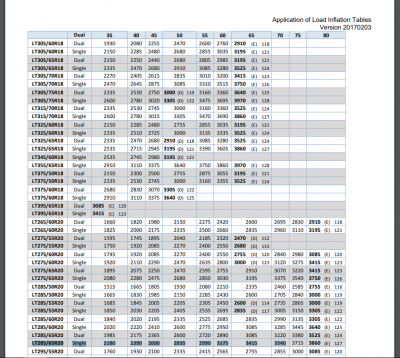It just seems to me that the only reason why it’s being reduced is because they’re not saying to run the max tire pressure stamped on the sidewall.... that’s just for everyday driving which is what the majority of which most people do. I mean, think about it; if they said to run the max pressure all the time, your ride quality is gonna go out the window. You might get a little better mileage having your tires that hard but at the same time you might create handling issues with your tires being that bouncy and might even cause a little bit of uneven tire wear to boot. I kinda hardly doubt the tire wear part because if it’s an OEM size on an OEM wheel, I don’t really think tire pressure is gonna change your contact patch a whole lot because back when I had my BFG’s, I still had every centimeter of the tread touching the road at even 65psi on an empty truck.
But take the rebel for example- if that thing comes with 10-ply tires, isn’t that placarded door sticker pressure a little light for that truck being fully loaded and/or hooked to a heavy trailer? Especially when I’m more than certain that for whatever the max weight capacity on those tires is, I’m pretty sure it says at 80 psi- and if it’s true that a heavier-plied tire needs more air to support the same weight as lesser-plied tire, how can that whole ten percent reduction thing even make sense? But whatever, just like I told the other guy- that’s not what I said, that’s just me repeating what three other major tire manufacturers said to me when I asked them about it.
Sent from my iPhone using Tapatalk
I think the max stated psi in the tire from the manfucaturers is just that, don't over inflate higher than that value for ??? reasons. Just like when we blow too much air in those party ballons i'd think. so theyre giving us max psi and max load, don't exceed.
With regards of max pressure at xx psi, i think the TRA specs were developed to provide manufacturers and us with a reference for load index parameters and how the tire should be rated across that range. in the case of an LT 285/70/17 size that seems to be 3195lbs at 80 if it was E, or 3195 at 65PSI if it was D, 2755lbs at 50 PSI if it was C. but in either case you don't need to go that high to have a truck fully loaded or adjust your PSI above the manufacturer guidelines per the placard
If we follow the TRA reference to go from P 275/60/20 to LT Rebel size 285/70/17 then we just need to exceed 2364 lbs (if we divide 2601 by 1.10 to account for P mounted on a truck)
in the case of LT 285/70/17 that should be 42 PSI at 2393lbs regardless if the tire was C or D or E.
If you didn't account for the 1.10 factor, then you'll be exceding the factory 2601lbs at just 47 psi (2608lbs per the TRA table) with that size tire.
And those values are actually higher than your truck GAWR per axel, which is also provided by the vehicle manufacturer. For a RAM 1500 4th gen Crew cab, that is 3900lbs per axel, so using those values we only need tires able to support 1950lbs per corner, which an LT 285/70/17 is exceeding at just 35psi.

Granted, this is taking the reference from the TRA table listed above from 2017
Current version is listed here
$125 for the yearbook or $250 for the digital reference.
http://www.us-tra.org/publications.html
And i don't know if values have changed from 2017. too much money to find out.
Tire manufacturers should also have a reference to their tires just like the TRA yearbook, TRA is not an enforcement but more of a guideline if anything i'd think tire manufacturers will try to meet or exceed those requirements. For us the guideline is just the reference to make the calculations when we change tire size otherwise we follow the placard if using the same tire as the truck came equipped originally.
Hope it helps.



